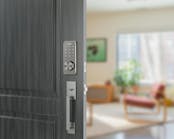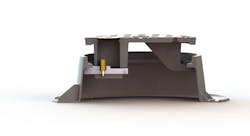This installment of TechTips will discuss some details concerning electromagnetic locking devices; we will cover design of the control circuits and remote control stations in a future installment.
An important aspect of specifying and installing electromagnetic locks is knowing when an electromagnetic lock is appropriate to use. Because the perception is that an electromagnetic lock is easy to install, end-users and dealers may be inclined to use them even if they are not the best choice for a door.
Remember that electromagnetic lock deployments are subject to close scrutiny by AHJs, and AHJs decisions vary, so we have no way of predicting how an AHJ will rule on your particular situation.
When electromagnetic locks were first introduced, the options available for electrically controlling openings were far more limited than they are now.
Additionally the applications for electrical door control were more limited due to expense, the perceived security risks in our culture, and the market’s knowledge and understanding of the potential uses for electric locking and the benefits which could be enjoyed.
While the types of electric locking devices available have greatly increased, the cost of hardware has gone down, the threat level has increased, and the ways in which electric locking systems can used continue to expand.
So while access control is the fastest growing industry category according to many studies, electromagnetic locks are not the fastest growing type of electric locking solution.
Electromagnetic Lock Characteristics
Fast acting: The electromagnetic field which holds the armature collapses upon loss of power. Assuring that the power is disconnected to the electromagnetic lock when it necessary, is what it is all about.
Sturdy & Simple: The electromagnet and armature are very robust with essentially no moving parts. However, electromagnets are susceptible to weather which will cause corrosion (which weakens the holding force significantly) and possibly power surges (which can cause the maglock to short out internally or the internal coil to open).
Requires Power to Lock: Electromagnetic locks are failsafe, meaning they require power to lock and unlock upon loss of power. The lock is well suited for emergencies where it is desirable to remove obstructions along the path of egress, but less suitable for doors which are used for security that should remain locked even when power is removed.
Yes, battery backup can be added to a system, and yes, the issue is partially mitigated if there is a backup generator for the building, but then a whole other set of variables come into play.
Will the system still satisfy the Authority Having Jurisdiction (AHJ) as safe in an emergency? AHJs find it very reassuring with the knowledge that if the building loses power, which is very common when there is a fire, the electromagnetic lock will unlock. PERIOD.
Adding a battery backup forces another layer of technology to the situation, and increases the possibility of something not working properly….in this case the door will remain locked when it should unlock. That’s the life safety issue.
Clients immediately think back to the worst storm of the century where they lost power for a week, then ask you how many batteries will it take and how much will it cost to secure the opening for a week with an electromagnetic lock? When they hear the cost, they start to rethink the electromagnetic lock idea.
If you have a backup generator, what is the lapse between when power fails and the generator kicks in and the maglock re-energizes? Will the door remain in a closed position in the absence of power to the maglock so when power comes back the maglock will grab? Many doors with maglocks tend to pop open when the maglock releases, either because of back pressure or door adjustment problems. So if the power fails, the door might pop ajar and the maglock will not be able to pull it shut. Obviously you have to address these concerns.
Installation
The mechanical mounting of an electromagnetic lock is considered simpler than a fresh install of other types of locking devices. However a careful site survey is recommended so that you can perform an efficient and successful installation.
Having a set of tools designated for electromagnetic lock jobs can be helpful because:
It might cut down on the trips from the van to the installation site.
I would be able to do a quick inventory of installation accessories on hand. Also I could protect from lost parts or what we call ‘road burn’ which is a term sometimes used to describe when finished surfaces on lock hardware gets scuffed from the friction between the items and other stuff. Clients do not like it when you install something blemished and you try to charge them full price.
I could also lend the kit to another crew to do installs so they could operate most efficiently. This is not recommended if the other mechanics are disrespectful of your stuff, or keep things you lend them if they feel like it.
Having a kit helps to train helpers by familiarizing themselves with the contents of the kit and knowing where to search when you send them for an ‘L‘ Bracket (hint: not in the glove compartment).
In A Class By Themselves
Electromagnetic locks are classified several difference ways.
Of the terms used in electronic security and electromagnetic locks, APPROVED, LISTED, RECOGNISED AND CERTIFIED are among the most important, and are also the most misused and understood.
UL (Underwriter’s Laboratories) is an independent, not for profit, testing laboratory. They perform tests on devices. They are not the only testing laboratory; others include Factory Mutual, US Testing, Warnock Hersey and ETL.
Once a device has been tested and passes UL testing, it will be UL Listed, UL Recognized or UL Certified.
UL Listed means that the product has passed testing. The UL label will show the category that UL has employed for testing. A panic bar might be labeled “Listed Exit Device;” a magnetic lock might be labeled “Listed Auxiliary Lock.” The label will also include a four letter code, for example “GWXT”; which is assigned based on the product category and type of tests. It is important that a device is listed for the application in which it is used, and installed in accordance with the manufacturer’s instructions and guidelines.
UL Recognized is the status UL grants to a component which needs to be combined with other components to create a finished product. For example, a line cord might carry a UL label. Using a UL recognized component with a non UL component does not elevate the non-UL component into compliance.
UL Certified means a product that has been successfully tested by UL to a non-UL standard, most often an ANSI standard.
Although the term UL Approved sounds impressive, there is no such thing as UL Approved.
The AHJ has the final word as to approval of a locking system. The AHJ may be a building Inspector Fire Marshal or other code official. Since the AHJ is the last person you will have to get an OK from, it stands to reason that he be the first entity you contact when planning and proposing a project.
Types of MagLocks & Accessories
GATE LOCKS: Electromagnetic locks which are typically weatherized and have provisions for wiring to come in through conduit. The conduit protects the electromagnet from foreign materials such as dirt and water, and also is protection against vandalism.
Any electromagnetic lock will work in either a horizontal or vertical position with the necessary brackets and mounting.
SHEAR LOCKS: Electromagnetic locks where the electromagnetic bond of the maglock is enhanced with an interlocking between the magnet and the armature.
SINGLE ELECTROMAGNETIC LOCKS are for single controlled doors
DOUBLE ELECTROMAGNETIC LOCKS can be two single electromagnetic locks mounted within a larger enclosure for aesthetics. The electromagnets can be individually controlled or simultaneously.
Sometimes a single electromagnet can be used with a split armature. Two shorter armatures are mounted on each door leaf, and the single electromagnetic lock is located at the center where the two doors meet. The door leaves cannot be controlled individually with the split armature. Also to holding force of the maglock is divided between the two armatures.
U-BRACKET FOR GLASS: An accessory which allows a maglock to be used on a frameless glass or Herculite door. An alternative to a U-Bracket is armature plates and special epoxy adhesive. The same epoxy can be used to attach other items to the glass door and sidelights. The bond is permanent once the adhesive cures.
Add-ons: Can include maglock cameras; motion sensors; delayed egress timers; and wireless remote release receivers .
L BRACKET: Often required to mount the electromagnet to the door frame. There are many kinds of door and header profiles, and each electromagnetic lock has unique mounting. L brackets are aluminum so they do not weaken the field of the electromagnet.
PLATE SPACER: Sometimes required to drop the electromagnetic lock’s mating face down to clear a blade stop used on aluminum doors. (You can also cut the blade stop out if you do not have a spacer)
Z BRACKET: Used for mounting electromagnetic locks on in swinging doors. The electromagnetic lock is best mounted on the interior or protected side of the opening. Generally doors will not open out into hallways because they present a safety hazard of opening into a passing pedestrian.
Z brackets are good for doors such as computer rooms where there are only a limited number of occupants and the door is not considered a means of egress for the building. Verify with your AHJ.
ARMATURE PLATE HOLDER: The armature is sometimes referred to as a moving part on the electromagnetic lock. Armatures are heavy metal bars mounted on the door to which the electromagnet is attaches when power is applied to the electromagnet. The armature mounts with a single large bolt which is designed to allow the armature to deflect so it can seat onto the surface of the electromagnetic lock. On the back of the armature are one or two ‘rolled pins’ sticking out the back of the armature and going into the door. These hold the armature horizontal (or vertical) position. So the moving is the armatures slight deflection and its location on a moving door,
The armature is usually held onto the door with a sex bolt thru the door. The sex bolt is basically two parts: a threaded flat head which goes through the armature, and a mating, internally threaded bolt which has a crowned cap but not slot of means to grasp and turn it which goes through the door and meets up with the armature bolt coming from the other direction. Metal and rubber spacers are typically part of the assembly. The manufacturer usually supplies some thread glue to use when assembling with the hope the sex bolt will not eventually loosen up from pounding and vibration, and the armature will fall on the ground or on someone’s head.
As previously mentioned, if the armature is mounting on a glass frameless or glass narrow framed door, the sex bolt cannot go through the door.
On aluminum storefront doors, there frequently is a threaded rod inside the upper frame of the door which holds the door together.
It is unwise to remove this bolt, and very hard to get the sex bolt to pass under it or over it. And since you will usually figure out you are having a problem AFTER the maglock has been mounted, even if you can move the sexbolt so it slips past the threaded rod, the armature will not properly align with electromagnetic lock or something will interfere with something else and you’re screwed.
So you can thread the sex bolt into the face of the door. Since the material used in the door is very thin, you are not going to get too many threads to hold the armature, and soon the armature will loosen up and the attorneys will be on the phone.
So briefly, (oops too late for that) you can resort to plan “B’” which is an offset armature where the hole of the sex bolt is not on the horizontal centerline of the armature, or Plan “C,’’ a robust aluminum plate with a threaded hole for the sex bolt and other holes to attach the armature mounting plate to the door, or lots of surface area for you to apply adhesive.
Here are some websites and products from reputable manufacturers of electromagnetic locks
DORMA EML Series
The DORMA EML series offers maglocks with holding forces from 300 pounds to 1500 pounds, available in both single- and double-door models for interior, perimeter, and cabinet.
The EMLSG360/365 specialized maglocks offer solutions for low profile sliding doors. The weather-resistant EMLSG385 specialized lock is ideal for perimeter security and internal gates. An innovative locking design incorporates a special alloy steel for greater durability and strength.
The EMDE delayed egress lock with built-in sensor detects pressure applied to outward swinging doors. Built-in sounder, voice, and CCTV monitoring combinations make this ideal for applications requiring loss prevention, life safety, and traffic control.
These mag locks are UL/CUL listed and contribute to U.S. Green Building Council, LEED® MR Credits 2.1, 4.1, 4.2 and 5.1
SDC E6200 Excel™ Series
This 1200 pound holding force magnetic lock is designed for exterior, perimeter and interior door security and access control. Magnetic bond sensor and door status outputs are included for remote monitoring, mantraps and system application needs.
- Retrofits Securitron M62 and Locknetics 70 locks
- Epoxy sealed electronics, tamper resistant and weatherized for indoor and outdoor use
- Stainless steel machine screws and blind nuts
- 10 ft jacketed, stranded conductor cable
- Dual voltage 12/24VDC
- Architectural stainless steel housing, US32/630
More Info: http://www.sdcsecurity.com/
RCI 8380 GateMag
With its rugged, stainless-steel housing, the weather-resistant GateMag is the ideal solution for perimeter security and internal gates. The standard Remote Lock Status (RLS) indicates whether the magnet is locked or unlocked, so you can easily monitor access from a remote location.
The GateMag electromagnetic lock features a built-in conduit fitting and an extra-long wire cable allowing easy wire access to an electrical box. Applications include sliding gates, swinging gates, tool cages, fences and storage areas.
More Info: http://www.rutherfordcontrols.com/en/products/electromagnetic-locks/
Alarm Controls Model 600WP
The Alarm Controls Model 600WP 600 lbs Weather-Proof Magnetic Gate Lock is ideal for sliding or swinging gates Non-aluminum parts are plated to resist corrosion/
Magnet size is 9-7/8" L x 1-11/16" H x 1" W and Armature size is 7-1/4" L x 1-7/16" H x 5/8" W. It operates on 12 or 24 VDC, switch selectable.
Low current draw: 250 mA at 12 VDC, 130 mA at 24 VDC
Operating temperature: +14 to +131F [-10 to +55C]
Product Features
- 12" color coded leads in armored cable with metal end cap
- Use 23/64" diameter drill for blind nuts provided with lock
- Self drilling TEC screws
- Completely sealed in stainless steel case
- Limited lifetime warranty
- Gate mounting brackets are available
- Available with 1200 lbs holding force. Order 1200WP
More Info: http://www.alarmcontrols.com/en/site/alarmcontrols/products/magnetic-locks/
SECO-LARM Electromagnetic Gate Lock
The Seco-Larm E-942FC-1K3SQ Electromagnetic Gate Lock is designed for most types of outdoor sliding and swinging electric gates. It includes a magnetic lock with brackets for armature and magnetthat can be welded or bolted directly to gate. Brackets are zinc-plated for corrosion resistance and in a black finish to match most gates.
Features include
- Maintenance-free, factory-sealed design.
- Fail-safe operation (releases if power is removed).
- Mount vertically or horizontally.
- Four knockouts on junction box.
- Adapter and mounting hardware included.
- Face mount.
More Info: http://www.seco-larm.com/
Securitron M62FG - SASM
This 1200 pound holding force weatherproof face-mounted Magnalock with conduit fitting and automatic dual voltage is for gate lock applications.
Shock Absorbing Strike Mount (SASM) controls excessive impact between the strike and the Magnalock, dramatically prolonging the life of the lock, gate and other hardware. SASM is available with the M62FG, or as an individual kit to retrofit existing M32, M62 or M82 Gate Magnalock installations. It is recommended for high security perimeter fence gates and electrically operated sliding gates.
More Info: http://www.securitron.com/en/site/securitron/products/magnalocks/
DYNALOCK 2013 Series
The DynaLock 2013 Series is a full size 1200 lbs. holding force electromagnetic lock, designed for high security on sliding and swinging gates, or any door subjected to the elements.
The 2013 is fully sealed with a 1/2” threaded conduit nipple for wiring from the side. Specify RWE option for wiring from back without a nipple (ex: mounting over a box). Optional Dynastat feature signals magnetic bond status. This allows integrated remote monitoring of the lock, reducing additional parts and labor.
The coil and housing assembly mounts rigidly to the post or frame while the armature mounts to the gate in a manner that allows it to pivot slightly to compensate for gate misalignment. When the gate is closed and the lock is energized the armature is magnetically bonded to the lock face, thus securing the gate without utilizing any moving parts.
More Info: http://electronic-security-systems.dynalock.com/category/electromagnetic-locks
Alarm Lock KIT RR-PM1200PAK
This innovative remote release mag-kit includes an advanced 1200 lb. Electromagnetic Lock with Infrared Remote Release. The plug-in 12VAC transformer eliminates the requirement for pulling wires or the services of an electrician (optional use). The AL-REMOTE Keyfob features single button operation with positive “click” response.
PowerMag™ 12/24V features:
- Strong holding force of 600 and 1200 lb. models
- Perfect for both single and double doors and even sliding doors
- 5-year limited warranty
- Low voltage (12 or 24VDC); including field-selectable models
- Double door models with 1200 lb. locking per side (PM1200SLB1 and 40)
More Info: http://www.alarmlock.com/magneticlocks.html
Tim O'Leary
Tim O'Leary is a security consultant, trainer and technician who has also been writing articles on all areas of locksmithing & physical security for many years.






